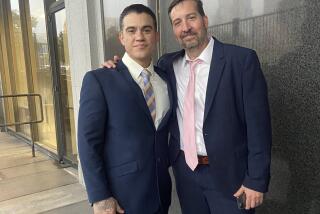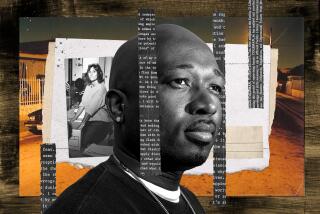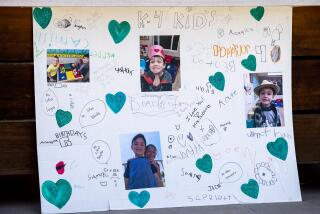Man Gets 26 Years to Life in Youth’s Killing : Trial: Despite arguments that his brother acted alone, Alexander Hines is sent to prison for apparent act of vengeance.
- Share via
When Gregory and Alexander Hines killed Jorge Rosales three years ago, the brothers were allegedly getting even because they thought Jorge had thrown a bottle at their mother.
On Friday, it was Jorge’s mother who sought vengeance in Ventura County Superior Court, where Alexander Hines was sentenced for the execution-style slaying of her 17-year-old son.
For the record:
12:00 a.m. Sept. 2, 1991 For the Record
Los Angeles Times Monday September 2, 1991 Ventura County Edition Metro Part B Page 4 Column 6 Zones Desk 1 inches; 24 words Type of Material: Correction
Murder case--A photo of Beatrix Haynes in the A-1 index of The Times on Saturday was misidentified. Haynes is the mother of convicted murderers Alexander and Gregory Hines.
“Why did he choose such a young victim?” Maria Rosales asked through an interpreter as she addressed the court. “He could have chosen someone his age who also had done bad things.”
Hines, 29, was sentenced to 26 years to life, the only sentence that Judge Lawrence Storch could impose under the law.
Storch had the option of making the sentence concurrent with an 18-year term Hines is already serving for sexually assaulting two adolescent girls. Instead, noting that the crimes were unrelated, Storch said Hines would serve the murder sentence after he does his time in the assault case.
Even allowing for time off for good behavior, Hines will have to serve 24 years in prison before he can be considered for parole, according to state guidelines.
“The execution style makes this case one of the most egregious slayings I have ever seen,” the judge said.
Court records give this account:
Jorge was partying at the Hines home in Oxnard in the early hours of July 16, 1988, when a fight broke out. The Hineses’ mother, Beatrix Haynes, tried to break up the fight but was struck by a flying bottle, blinding her in one eye.
At the hospital with their mother, witnesses testified, the brothers were furious and vowed to get revenge. They left the hospital about 4 a.m. with Jorge and returned two hours later without him.
About 6:20 a.m., a farm worker found the teen-ager’s body in a field near Camarillo. He had been shot twice in the face at close range with a shotgun.
The brothers were held briefly but were released for lack of evidence. By the time investigators had built a case against them, they had fled the area and adopted aliases. They eluded arrest until both were back in custody late last year.
In surprise testimony at their trial last month, Gregory Hines admitted that he killed Jorge but insisted he had acted alone. Deputy Dist. Atty. Donald C. Glynn dismissed the testimony, saying Gregory Hines knew he was going to be convicted and was trying to save his brother. The jury, apparently, agreed.
Before the sentencing, Alexander Hines’ attorney, Deputy Public Defender Robert Willey, repeated his view that the case against his client never should have gone to the jury. He asked for a new trial, saying Storch had erred in not dismissing the case for lack of evidence. He argued that the only evidence tying his client to the murder scene was a single footprint made by the same type of shoe that Alexander had.
Storch denied the request. “It’s not the strongest case of circumstantial evidence I’ve ever seen,” the judge said. But considering all the evidence, he added, there was enough of a case to let the jury decide.
Glynn said the footprint--combined with Alexander’s motive, his statements at the hospital and the fact that he left with the victim--added up to a strong case. The shotgun used in the slaying belonged to Gregory Hines and had been seen in Alexander Hines’ car the night before the shooting.
Gregory Hines, 20, also appeared in court Friday, but his sentencing was postponed for several months until he can be evaluated by the California Youth Authority. He was 17 when the crime occurred, and state law requires a CYA evaluation before a judge can consider sending a minor to prison.
Security was unusually tight during the brothers’ court appearances. Spectators had to walk through an airport-style metal detector, and 14 sheriff’s deputies--instead of the usual two or three--kept an eye on the spectators, who included members of both the defendants’ family and the victim’s.
Several of the dead youth’s relatives sobbed loudly as Maria Rosales addressed the judge during the sentencing. She questioned why her son was killed to avenge a mother’s loss of an eye. Investigators say it has never been established that the bottle that blinded Haynes was thrown by Jorge.
“His mother is still alive,” Rosales said. “I don’t have a son anymore.”
After the defendants were led back to jail and the courtroom was cleared, Haynes slowly made her way down the deserted hallway. Wiping tears from behind the dark glasses she wears to cover her eye injury, she said she resented Rosales’ comments.
“I’m a mother, too,” she said. “Her son is resting in peace. My sons are suffering. They are not free. I am not free.
“She lost a son, but I am losing two sons.”
More to Read
Sign up for Essential California
The most important California stories and recommendations in your inbox every morning.
You may occasionally receive promotional content from the Los Angeles Times.










